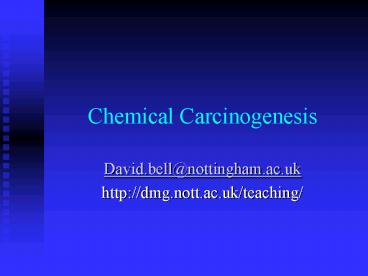Chemical Carcinogenesis - PowerPoint PPT Presentation
1 / 25
Title:
Chemical Carcinogenesis
Description:
Cause cancer in mouse, rat, monkey, guinea-pig, rabbit, fowl, newt, trout ... Tumorigenic in rat, mouse, guinea pig and fish (everything tested) ... – PowerPoint PPT presentation
Number of Views:97
Avg rating:3.0/5.0
Title: Chemical Carcinogenesis
1
Chemical Carcinogenesis
- David.bell_at_nottingham.ac.uk
- http//dmg.nott.ac.uk/teaching/
2
Do chemicals cause cancer ?
- Epidemiology
- The study of illness in populations
- Correlate with influences on the population, eg
diet, work, geography - 1775
- The surgeon, Percival Potts, noted that coal
sweeps had a high incidence of cancer, scrotal
cancer. He hypothesised that the cancer was due
to their intimate and prolonged exposure to coal
dust.
3
Latency
Cancer takes 10-50 years to develop in man
1900- Cigarette smoking an accepted habit
1940- rise in male lung cancer- alarm
1960- smoking is shown to be the cause of lung
cancer
1960-2000. People who started smoking before
1960 die of lung cancer Lung cancer is the most
frequent site of cancer in UK men
4
Causes of cancer
Note that diet, tobacco, occupation, alcohol and
pollution are principally chemically-induced
cancers.
5
Screening for carcinogens
- Animal tests
- 50 animals per group
- Maximal tolerated dose (MTD), and 25
- Cost 250 000
- Time 2 years (rat or mouse)
6
Problems with bioassay
- The US National Toxicology Programme has tested gt
300 compounds, with selection based solely on
environmental relevance - Approx 50-66 of all chemicals cause cancer
7
Nitrosamines
- Cause cancer in mouse, rat, monkey, guinea-pig,
rabbit, fowl, newt, trout - Wide range of organs affected
- Formed in food in the presence of nitrate, and
acid, ie pickles - Potent
R1
N
NO
R2
8
Nitrosamines
O-H
CH2
CH3
Oxidation
N
NO
N
NO
CH3
CH3
The methyl carbonium ion is a powerful
electrophile, and reacts quickly with
macromolecules.
H2-CO
CH3-NN-OH
N2
CH3-N2
CH3
OH-
9
Electrophiles
- Chemical entities which react with centres having
a surplus of electrons, or nucleo-philes. - Protein, RNA and DNA contain nucleophilic sites
10
Electrophiles and DNA 2
H
- There are multiple reactions of electrophiles
with DNA - O6 methyl guanine is promutagenic
- The alkylated base mispairs G-T, instead of G C
- This leads to inaccurate repair, and mutations in
DNA - N7-G also promutagenic
N7
O
N
N
N
N
H2N
Guanine
dR
11
Genotoxicity
- Toxicity to the genome- hence genotoxicity
12
Benzo(a)pyrene
1
Bay region
2
10
3
9
4
8
5
7
6
K region
High electron density at Bay and K regions Planar
molecule
13
Benzo(a)pyrene
- Typical PAH
- Ubiquitous
- Coal tar, organic matter
- Formed during combustion of organics
- Cooking !
- Oils, especially used at high temperature
- Chemically inert
- Principal active agent in coal tar
14
B(a)P metabolism
Multiple sites of metabolism combination of
metabolism at multiple sites. Highly
complex metabolic pathways.
2
10
3
9
4
8
5
7
6
Hydroxylation- reactive phenols and quinones
15
The ultimate carcinogen
Cytochrome P450
O
B(a)P 7,8 epoxide
Epoxide hydrolase
P450
O
OH
OH
OH
OH
((anti))B(a)P 7,8 dihydrodiol 9,10 epoxide
B(a)P 7,8 dihydrodiol
16
Is BPDE important ?
- Analysis of B(a)P- DNA adducts
- BPDE should be more carcinogenic than BP
- Dose mice at birth and autopsy at 7 months. Lung
tumours/mouse are shown.
17
Adducts from B(a)P
- Adducts form on C10- N2 of dG using the BPDE on
DNA in vitro - The same adducts are formed in vivo on DNA
- Mutations in the ras oncogene with BaP are
typified by G-T transitions at codon 12 or 13
18
DNA repair
- Methylnitrosourea (MNU) is a direct alkylating
agent - In rats, it has tissue-specificity, with
brain-specific tumorigenesis - DNA-adduct levels are similar in brain in liver
- Adducts are removed rapidly in liver, but persist
in brain
19
DNA damage ? cancer
DNA damage is similar between the two
strains Tumour development is markedly
different Therefore other factors control the
development of cancer
20
Do adducts cause cancer ?
- Chemically synthesise DNA-adducts, insert into
plasmid and transform into E. coli - Measure amount of mutations in prokaryotic DNA
- Treat a cellular proto-oncogene with carcinogen
in vitro - Transform DNA into cells, and look for cellular
transformation
21
How many adducts for cancer ?
- For a 50 incidence of tumours in rat liver
- Estimate from 50 to 2000 adducts/ 108 nucleotides
(2 per 100 000) - Variation
- Measurement
- Repair
- Different compounds and adducts
22
The numbering of the beast
4
6
3
5
7
8
2
10
9
1
2,3,7,8 tetrachlorodibenzo-p-dioxin (TCDD) One of
the most potent of a variety of related
compounds Long half-life in humans (6 years)
23
TCDD and cancer
- Tumorigenic in rat, mouse, guinea pig and fish
(everything tested) - Primate study aborted when total dose of 2 mg/kg
lead to death - In rat, the lowest carcinogenic dose was 1.4
ng/kg/day (Plt0.05) for thyroid tumours - MTD 71ng/kg/day
24
A prototypical non-genotoxin
- TCDD is a potent carcinogen
- Very weak/ no mutagenicity in Ames test
- No activity in tests of initiation activity
- Maximum estimate for binding of TCDD to rat liver
DNA 1 molecule per 1011 bases - 1 per 107- 105 for known carcinogens
- TCDD is a non-genotoxic carcinogen
25
Chemical carcinogenesis
- Chemicals are involved in 60-80 of human cancers
- Reaction of chemical with DNA
- Some chemicals require metabolic activation
- Non-genotoxic chemicals
- Activation of cellular receptors

